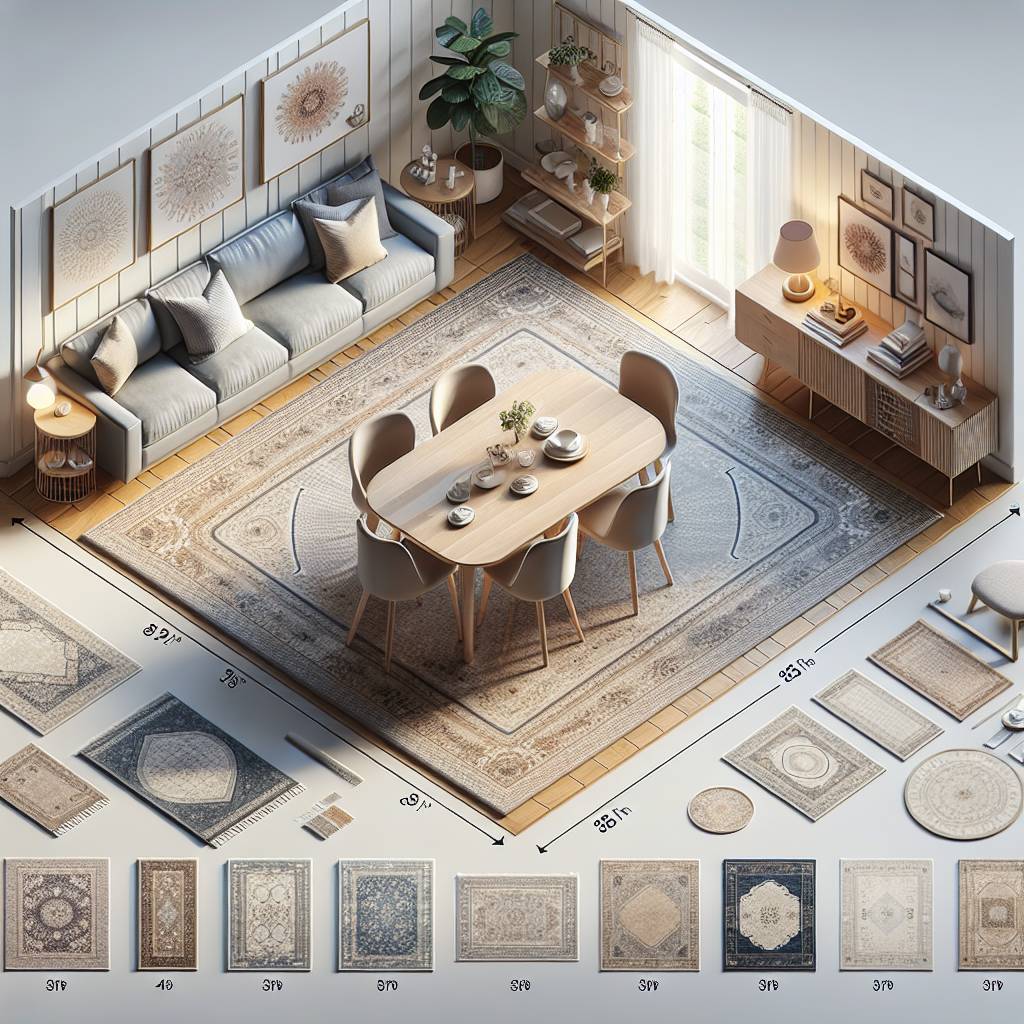Finding the perfect rug size for a small dining room can be a game-changer. It’s all about striking the right balance between creating a cozy, inviting space and ensuring that your rug doesn’t overwhelm the room. The challenge lies in making sure your pile rug is large enough to accommodate the dining chairs while not encroaching on the limited floor area of the room size.
Every inch counts. A well-chosen rug has the potential to visually expand your space, adding warmth and personality without dominating the whole room.
Key Takeaways
- Measure your dining space: Take accurate measurements of your dining area to ensure the rug fits perfectly and complements the room’s layout.
- Match rug size to table dimensions: Choose a rug that accommodates the dining table and chairs, leaving enough space for movement and pulling out chairs.
- Consider rug shape and placement: Select a rug shape and placement that enhances the visual appeal of the dining area while maintaining functionality.
- Pay attention to patterns and colors: Opt for rug patterns and colors that complement the room’s decor and add visual interest without overwhelming the space.
- Choose the right material: Select a rug material that is durable, easy to clean, and adds warmth and comfort to the dining area.
- Maximize aesthetics with proper sizing: By carefully considering all factors, you can maximize the aesthetics of your small dining room with the right rug size, creating a visually appealing and functional space.
Understanding Rug Size Importance for Small Rooms
Impact on Visual Appeal
Choosing the right rug size is crucial for small dining rooms. A rug that’s too small can make the room feel disjointed and cluttered, while a rug that’s too large might overwhelm the space. The wrong size rug can throw off the visual balance of the entire room’s tones.
The wrong rug size can visually shrink a small dining room, making it feel even more cramped than it actually is. On the other hand, choosing a properly sized rug can create an illusion of a larger space by providing a cohesive and visually appealing foundation for the furniture.
For example:
- Placing an undersized rug under the dining table in a small room leaves much of the floor exposed, creating an unbalanced look.
- In contrast, using a well-proportioned rug that fits under all furniture legs creates harmony and makes the room appear more put together.
Impact on Functionality
The size of the rug also significantly affects how functional and comfortable your small dining area feels. A too-small rug may not provide enough coverage to protect your flooring or accommodate chair movement during meals. Conversely, an excessively large rug could extend beyond usable space or become tripping hazards.
A properly sized rug size enhances functionality by defining and anchoring your dining area within its limited square footage. It helps absorb noise from moving chairs and provides warmth underfoot without overwhelming or obstructing traffic flow in tight spaces with the perfect dining room rug.
Measuring Your Dining Space for the Perfect Rug Fit
Importance of Accurate Measurements
Accurate measurements play a crucial role in ensuring the right size rug for a small dining room.Precision is key. By measuring your dining space accurately, you can avoid purchasing a rug that is either too large or too small for the area.
Taking into account both the width and length of your dining space is essential when determining the correct dimensions for your rug. Considering any potential obstructions such as furniture legs, walkways, and a new rug will help ensure that you choose an ideal size that fits comfortably within the room without obstructing movement.
Measuring your dining area involves more than just obtaining basic measurements; it also requires careful consideration of how much space you want to cover with the rug. This process allows you to determine whether there’s enough space around the edges of your dining table to accommodate chairs comfortably while still leaving ample room for walking around.
Furniture Placement and Walkways
When selecting a rug size for a small dining room, taking into account furniture placement and walkways is crucial. You’ll need to measure not only around but also underneath each piece of furniture in order to establish clear boundaries for where the rug should sit.
For instance, if you have a round table in your small dining area, consider choosing a round or square-shaped rug that extends beyond all chair legs when they are pulled out from under the table. On the other hand, if you have a rectangular or oval-shaped table, opt for an appropriately sized rectangular or oval-shaped rug that accommodates all four legs of each chair even when they are pushed back from sitting at the table.
Matching Rug Size to Dining Table Dimensions
Consider the Table Size
When choosing the right rug size for a small dining room, it’s crucial to consider the dimensions of your dining table. A general rule is to select a rug that extends at least 24 inches beyond all sides of the table. For instance, if you have a square table measuring 4 feet by 4 feet, you should aim for a rug that measures at least 8 feet by 8 feet.
It’s important to note that this guideline ensures there’s ample space for chairs even when they are pulled out from the table, perfect dining room rug. By providing extra coverage around the dining area, it not only creates a cohesive and visually pleasing look but also prevents chairs from catching on edges or slipping off when seated.
Visual Cohesion
Properly matching the rug size to the dimensions of your dining table contributes significantly to visual cohesion within your small dining room. When both elements are proportionate in size, they work together harmoniously and create an aesthetically pleasing balance in the space.
Imagine walking into a small dining area with a perfectly sized rug under a well-proportioned table; it immediately feels inviting and well put together. On top of adding style and warmth to your space, this deliberate choice can make your compact dining room appear more spacious than it actually is.
Selecting the Appropriate Rug Shape and Placement
Different Shapes
Considering different shapes is crucial. Rectangular rugs are a popular choice, but round or square rugs can also work well in smaller spaces. Each shape offers unique benefits based on the layout of the room. For instance, a rectangular rug can complement the long shape of a narrow dining area, while a round rug can soften sharp corners and add visual interest.
It’s important to visualize how each shape will fit within the space before making a decision. A round rug could be an excellent option if you want to create a cozy, intimate feel in your small dining room. On the other hand, if you’re aiming for symmetry or have limited floor space around your table, consider opting for either a square or rectangular rug.
Focal Point and Definition
Placing the perfectrug centered under your dining table creates an appealing focal point and effectively defines the dining area within your small room. By doing this, you not only enhance visual appeal but also make optimal use of available space. When choosing where to position your new rug under the table, ensure that it extends beyond all sides of the table by at least 24 inches so that chairs remain comfortably positioned on it even when pulled out.
This placement serves as both functional and aesthetic; it frames not just your dining set but also visually expands its presence in relation to surrounding furniture pieces or walls. Ensuring that chairs’ hind legs stay on top of pile rugs rather than off them provides stability during seating movements while preventing potential tripping hazards.
The Visual Impact of Rug Patterns and Colors
Creating the Illusion of Space
The pattern and color play a crucial role in visually expanding or shrinking the space. Light-colored rugs with subtle patterns can make a small dining room appear more spacious. For example, a cream or light gray rug with minimalistic patterns can create an illusion of openness, making the room feel less cramped. On the other hand, bold and busy patterns on dark-colored rugs might overwhelm a small dining area, making it seem even smaller than it actually is.
Pairing light-colored rugs with soft hues such as pastel blues or pale yellows can further enhance this effect by creating an airy and open ambiance. These colors help reflect natural light, contributing to an overall brighter look that makes the space feel more expansive.
Harmonizing With Overall Decor
In addition to creating an illusion of space, the rug’s design should complement the overall decor of a small dining room. By harmonizing both colors and patterns with existing furniture and wall tones, you can achieve a cohesive look that enhances aesthetics rather than overpowering them. For instance, if your dining chairs feature floral upholstery in muted tones, consider selecting a rug with complementary colors but simpler patterns to avoid overwhelming visual clutter.
The goal is not only to choose a rug that complements your furniture but also one that ties everything together cohesively without being too much of a focal point itself. This approach ensures that while adding warmth and style through your choice of rug design, you’re also maintaining balance within the limited space available in small dining rooms.
Material Matters for Small Dining Room Rugs
Importance of Rug Material
When selecting a rug for a small dining room, choosing the right material is crucial. The material not only affects the durability of the rug but also contributes to its visual appeal. Natural fibers like wool or cotton are popular choices due to their sturdiness and low maintenance. These materials can withstand heavy foot traffic and frequent cleaning, making them ideal for small dining spaces where spills and crumbs are common occurrences.
In contrast, synthetic materials offer an alternative that may be more budget-friendly but could compromise on quality and longevity. While they might provide initial cost savings, it’s essential to consider their durability over time when placed under a dining set.
Considerations for Durability
The presence of furniture pieces in a small dining room necessitates careful consideration of rug materials. For instance, chairs with wooden legs can potentially cause damage to rugs made from delicate fabrics or those with high pile heights. Opting for a low-pile rug constructed from durable materials ensures that chair legs won’t get caught in the fibers while providing ease of movement during meal times.
Moreover, when hosting guests, especially in compact dining areas, spillages are almost inevitable. Therefore, choosing a material that is easy to clean becomes paramount in maintaining both the appearance and functionality of the rug.
Pros and Cons
Pros:
- Wool or cotton rugs offer durability suitable for high-traffic areas.
- Synthetic materials provide cost-effective options.
Cons:
- Synthetic rugs may lack longevity compared to natural fiber alternatives.
- Delicate fabrics may be susceptible to damage from furniture legs.
Tips for Decorating with Rugs in Compact Dining Areas
Layering Rugs
Layering rugs in a small dining room can bring depth and texture to the space, enhancing its visual appeal. By layering a smaller rug on top of a larger one, you create an interesting focal point while maintaining proper scale within the compact area. For instance, placing a round rug on top of a larger rectangular one can add visual interest and define the dining space within an open floor plan.
When choosing rugs for layering, ensure they complement each other in terms of color and pattern. The bottom rug should have a subtle or solid design to provide a neutral base for the more intricate top rug. This technique not only adds style but also helps protect the flooring underneath from wear and tear.
Layered rugs are also practical as they offer additional cushioning underfoot, making them ideal for areas where people often sit for extended periods such as during meals or gatherings.
Rug Pad Utilization
Using a rug pad underneath your dining room rug is crucial, especially in compact spaces where slipping could be hazardous. A quality rug pad not only prevents accidents by keeping the rug securely in place but also provides extra cushioning underfoot.
In small dining rooms with limited space for furniture movement, it’s essential to keep the rugs firmly anchored to avoid any potential tripping hazards. Using a rug pad helps extend the lifespan of both your rug and flooring by acting as a protective barrier against friction and scratches caused by foot traffic.
Rug pads come in various materials like rubber or felt; choose one that suits your specific needs based on factors such as floor type and desired level of cushioning.
Style Considerations
When selecting a rug for your small dining room, consider how it complements the existing decor style and theme of the room. For example, if you have modern minimalist decor with clean lines and neutral tones, opt for a simple yet elegant rug that doesn’t overpower the space visually. On the other hand, if your dining area features bold colors or patterns, choose a complementary rug that enhances the overall aesthetic without clashing with existing elements. The goal is to select A size-appropriate carpet that harmonizes with rather than competes against other design elements, including dining room furniture for small spaces, present in this intimate setting.
Factors to Consider for Optimal Rug Size Selection
Room Size and Furniture Layout
When selecting the right size rug for a small dining room, it’s crucial to consider the dimensions of the space and how furniture is arranged. In a compact dining area, a rug that is too large can overwhelm the room, while one that is too small may get lost in the layout. For instance, in a square-shaped dining room with a table placed at the center, an appropriately sized rug should extend beyond the chairs when they are pulled out but not touch or go under any nearby furniture.
Considering these aspects ensures that there is enough coverage beneath seating areas without encroaching on other pieces of furniture. This creates a harmonious balance between all elements within the confined space.
Visual Proportion and Balance
Achieving visual proportion and balance between the right size rug and other elements in a small dining area is essential for aesthetic appeal. A well-proportioned rug can visually expand or define specific zones within this limited space, including Dining Room Furniture for Small Spaces. For example, in an open-plan living-dining area where both spaces share common flooring, using rugs of different sizes can help delineate each zone effectively.
Incorporating rugs of appropriate sizes prevents overcrowding or sparseness while enhancing visual harmony throughout the entire room. It also helps create an illusion of more expansive floor space by maintaining balanced proportions between various design components.
Personal Preferences and Lifestyle Needs
Personal preferences play a significant role in choosing an optimal rug size for small dining rooms. Individuals might prefer larger rugs if they entertain frequently or have young children who often play on the floor during meals. On the other hand, those who prioritize ease of maintenance might opt for smaller-sized rugs that are easier to clean and move around when necessary.
Considering lifestyle needs such as cleaning convenience, durability against heavy foot traffic, and comfort underfoot enables individuals to select the right size rug that aligns with their daily routines and habits.
Maximizing Small Dining Room Aesthetics with Proper Rug Sizing
Defining the Space
Choosing the perfect dining room rug is crucial for creating an inviting and visually appealing space. The right rug size helps define the dining area, making it feel cohesive within the overall room design. By placing a properly sized rug under your dining table, you can establish boundaries for the space and enhance its visual appeal.
Properly sizing a rug in a small dining room is essential as it creates a sense of harmony between all elements present in the room. Imagine walking into a small dining area where there’s no defined boundary between where the table ends and where the rest of the room begins. It may create an awkward visual effect that disrupts the flow of your interior design. However, by selecting an appropriately sized rug, you can clearly delineate your dining space from other areas within the same room.
Enhancing Coziness
In addition to defining spatial boundaries, choosing a dining room rug size that fits well with your furniture placement contributes to enhancing coziness in your small dining area. Placing all chair legs on or off of the rug depends on personal preference and available space but ensuring that they are consistent throughout will help maintain balance in terms of aesthetics.
The proper selection of material also plays a significant role when considering rugs for small spaces such as dining rooms. Opting for materials like wool or cotton can add warmth and texture to your tiny eating area while providing comfort underfoot during meals.
Final Remarks
You’ve now mastered the art of choosing the right rug size for small dining rooms. By understanding the importance of rug size, measuring your dining space, and considering factors like table dimensions, shape, placement, patterns, colors, and materials, you’re well-equipped to enhance your compact dining area. Remember, the right rug can tie the room together and create a cozy, inviting atmosphere. So go ahead and put your newfound knowledge into action – measure your space, pick out the perfect rug, and watch how it transforms your dining area into a stylish and functional space that wows everyone who enters.
Frequently Asked Questions
What is the significance of choosing the right rug size for a small dining room?
Selecting the right rug size for a small dining room is crucial as it can visually expand the space, enhance acoustics, and provide comfort underfoot. A well-fitted rug can tie together the entire dining area, creating a cohesive and inviting ambiance.
How do I measure my dining space to find the perfect rug fit?
To measure your dining space for an ideal rug fit, start by ensuring that there’s at least 24 inches of extra space on all sides of your table. This allowance accommodates chairs comfortably even when they’re pulled out. Measure carefully to ensure accuracy in selecting the appropriate rug dimensions.
What factors should I consider when selecting an appropriate rug shape and placement for my small dining room?
When choosing a rug shape and placement for a compact dining area, consider options like round or square rugs to complement smaller spaces. Placing the rug so that it extends beyond the table’s edges helps define the seating area while providing visual balance within the room.
How does material selection impact small dining room rugs?
The material of your chosen rug impacts both its aesthetics and functionality in a small dining area. Opt for durable materials like wool or polypropylene that are easy to clean and maintain. These materials also offer softness underfoot without overwhelming limited floor space.
Can you share tips for decorating with rugs in compact dining areas?
In smaller dining rooms, opt for lighter-colored rugs to create an illusion of spaciousness. Consider using simple patterns or solid colors to avoid overwhelming visual clutter. Ensure that any furniture legs sit comfortably on top of the rug rather than half on/half off.






